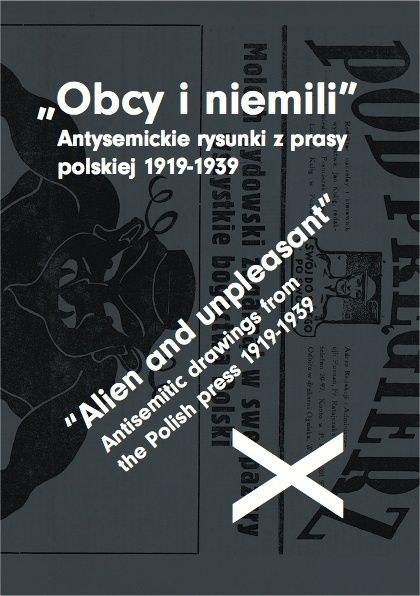
The opening of the exhibition: 15th October, 2013 at 18.00
The exhibition is open till 31st January, 2014
Place:
Tłomackie 3/5
00–090 Warsaw
Already on 15th October at the opening of the exhibition „Alien and Unpleasant. Anti-semitic drawings from the Polish press of 1919–1939” over 300 works published in the Polish press in the years 1919–1939 will be presented. Caricatures — accompanying the anti-Semitic articles — were an important factor in shaping the image of the Jew, and thus influenced the feeling and views on „the Jewish question”. The exhibition will be accompanied by a screening of a film about hate speech, which features Prof Jerzy Bralczyk, Prof Michal Glowinski, Prof Irena Kaminska-Szmaj, Piotr Forecki and Bozena Keff. The organizer of the exhibition is the Emanuel Ringelblum Jewish Historical Institute in Warsaw.
Anti-semitic caricatures surprise in terms of their variety, but they have a common denominator: they all incite to hatred. In a simple and understandable way they show Jews as intruders and enemies. They emphasize, among others, stereotypical Jewish racial traits, both physical and mental.
„The image of the Jew, that emerges from the drawings from the Polish press of 1919–1939 is scary and beyond belief,” says Teresa Śmiechowska, Head of the Art Department of the Emanuel Ringelblum Jewish Historical Institute in Warsaw.
Anti-semitic works showed a symbolic image of the Jew striving for domination over Poland and the Polish. He was supposed to be the perpetrator of all the evil in the country. At the same time they suggested ways to solve „the Jewish question”, for example by popularizing the idea of economic struggle, ghetto benches, Aryan paragraph, displacement. There were also works which expressed approval for the anti-Jewish actions in Nazi Germany and Fascist Italy.
„The image of the Jew presented in press illustrations is seen as a creature repulsing by his physicality and mentality, so different, alien and frightening as only a demon, monster, or animal arousing abomination can be. In the presented drawings the Jew is dehumanized, depersonalized, reduced to anonymous, typical representative of „the Jewish race”” says Dariusz Konstantynow, the curator of the exhibition.
Famous and anonymous authors
The exhibited works were published during the interwar period in papers including: „Kurier Poznański”, „Dziennik Bydgoski”, „ABC-Nowiny Codzienne”, „Wieczór Warszawski”, „Podbipięta”, „Prosto z mostu”, „Szczutek”, „Szopka”, „Mucha”, „Żółtea Mucha”, „Szarża”, „Pokrzywy”, „Szabes-Kurier”. The authors of the drawings were both well-known professional artists (including Jerzy Zaruba, Kamil Mackiewicz, Włodzimierz Bartoszewicz, Włodzimierz Łukasik, Jerzy Srokowski, Kazimierz Grus i Maja Berezowska) and anonymous ones, hiding behind monograms and pseudonyms.
The satirical image of the Jew in the European press
Anti-Semitic drawings in the Polish press have their wider European context. An important turning point for Central Europe was the rise of political anti-semitism in the States of Germany. Anti-Semitic agitation was accompanied by malicious illustration. In the Austro-Hungarian Empire, satirical magazine Kikeriki (actually Kikeriki! Wiener humoristisches Volksblatt) was published since 1861. Anti-Jewish prejudices and modern anti-Semitic stereotypes cultivated for centuries found their illustrative comment in French satirical magazines, including Le Mirliton, La Caricature or Le Canard Sauvage. Drawings by Parisian artists were published in the press of francophone countries, including Belgium, Switzerland, and also in the Latin countries, especially in Italy, Romania and Spain. However, in Eastern Europe scathing images of Jews spread with the expansion of the mass press, which took place after the Revolution of 1905. After the First World War the most aggressive satirical anti-Semitic writings started to emerge in Germany, such as „Der Stürmer” of Julius Streicher (published since 1923). Polish anti-Semitic caricature joined the global market of ethnic hatred in the late 1900s.
Hate speech
The language of superiority, contempt, and hatred, which is reflected in the objects at the exhibition „Alien and Unpleasant”, takes the floor again today, albeit in a different form. Manifestations of hostile emotions are visible in extreme antagonistic ideologies that seem to be gaining momentum. Therefore it is important to remember that what seemed to be only a joke and a symbolic violence in caricature drawings, reinforced prejudice and racial stereotypes which took a toll.
Curator of the exhibition:
Dariusz Konstantynow
Curatorial collaboration:
Grzegorz Krzywiec
Teresa Śmiechowska
Dates:
The opening of the exhibition: 15th October, 2013 at 18.00
The exhibition is open till 31st January, 2014
Place:
Jewish Historical Institute
Tłomackie 3/5
00–090 Warsaw
/image%2F0947248%2F20141221%2Fob_0040c8_cc-14383b.jpg)